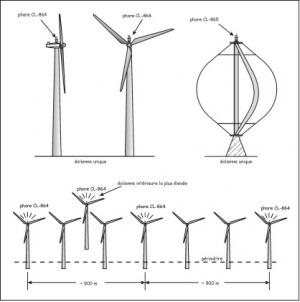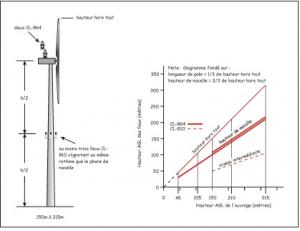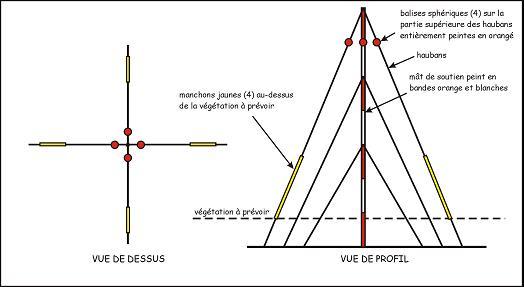NCR-034-2018
Pursuant to subsection 5.9(2) of the Aeronautics Act, and after taking into account that the exemption is in the public interest and is not likely to adversely affect aviation safety or security, I hereby exempt Canadian wind farm owners/operators from the requirements of paragraph 12.3(2)(a) of Standard 621 – Chapter 12 – Marking and Lighting of Wind turbines and Wind farms made pursuant to paragraph 601.24(2)(a) of the Canadian Aviation Regulations (CARs), subject to the following conditions.
Details of paragraph 601. 24(2)(a) of the CARs and paragraph 12.3(2)(a) of Standard 621 are set out in Appendix A of this exemption.
Purpose
This exemption enables the person who has responsibility for or control over a Canadian wind farm to use two CL-864 horizontally separated lights with one operating and one standby in place of a vertical arrangement with the lights installed on top of each other as prescribed in paragraph 12.3(2)(a) of Standard 621, so as to meet the intent rather than the letter of the requirement. That is, to minimize blockage of light output upon failure of one of the light units.Application
This exemption applies to the person who has responsibility for or control over a Canadian wind farm and who plans to install top lights required in Chapter 12, paragraph 12.3(2)(a) of Standard 621. The installation of two lights applies to wind turbines that have a height of more than 150 m.
This exemption ceases to apply to a person breaching a condition of the exemption.
Conditions
This exemption is subject to the following conditions:
The person who has responsibility for or control over a Canadian wind farm shall ensure that:
- the lights are of type CL-864 and installed so that the amount of light blockage will be minimized;
- where the lights are installed horizontally, the spacing is not less than 1.0 m.
Validity
This exemption is in effect until the earliest of the following:
- a) January 31, 2021, at 23:59 EST;
- b) the date on which any condition set out in this exemption is breached;
- c) the date on which the design criteria of the exempted lighting (CL-864) are incorporated in Standard 621 – Chapter 12 – Marking and Lighting of Wind turbines and Wind farm;
- d) the date on which the exemption is cancelled by the Minister, in writing, where he is of the opinion that it is no longer in the public interest or that it is likely to adversely affect aviation safety or security.
Dated at Ottawa, Ontario, on this 7th day of February, 2019, on behalf of the Minister of Transport.
“Original signed by”
Nicholas Robinson
Director General
Civil Aviation
Appendix A
Relevant CARs excerpts:
601.24 (1) Any person who plans to construct or modify a building, structure or object, or launch a tethered object shall notify the Minister of the proposed construction, modification or launch in accordance with the requirements of Standard 621 if the building, structure or object, or tethered object, will constitute an obstacle to air navigation.
(2) A person who has responsibility for or control over a building, structure or object that constitutes an obstacle to air navigation shall
- a) mark and light the building, structure or object in accordance with the requirements of Standard 621; or
- b) use the equivalent marking and lighting approved by the Minister under subsection 601.27(2).
=================================
Chapter 12 - Marking and Lighting of Wind turbines and Wind farms
12.1 Scope
Chapter 12 governs the marking and lighting of a wind turbine and a wind turbine farm.
Information Note 1: The definition of wind farm is based on the premise that the installation of three wind turbines is the first instance for which omission of lighting might be made. Since the exterior wind turbines [on the perimeter] of a wind farm are to be lighted, a grouping of only two wind turbines would require that both be lighted. In the case of three wind turbines lighting of the inner wind turbine may be omitted depending upon spacing.
Information Note 2: The application of these requirements can vary in accordance with the provisions of this Standard depending on terrain features, geographic location, overall layout of the structures, and normal angles of approach.
Information Note 3: The provision of lighting on wind turbines and wind farms should be done in a fashion as to minimize the possibility of bird fatalities and interference with nighttime astronomical study.
l2.2 Wind turbines of Total Height Equal to or Less than 150 m
(1) Marking Requirements - Day Protection
(a) For a single wind turbine and wind turbines of a wind farm, having a solid silhouette, the rotor blades, nacelle and upper 2/3 of the supporting mast are painted a white or an off-white colour.
(b) A wind turbine having a lattice-work support mast has the mast painted in bands of orange and white as for skeletal structures.
Information Note: The above specified colours can be found in the RAL colour system as …
Orange - 2009
White - 9010
Off-white -7035 (light grey)
(2) Lighting Requirements - Twilight and Night Protection
For Night Protection, a single wind turbine and wind turbines of a wind farm are lighted as illustrated in Figure 12-1 and as follows:
(a) For a single wind turbine:
(i) A wind turbine is lighted with use of a CL-864 light unit for twilight and nighttime operation for horizontal turbines or a CL-865 light unit for daytime, twilight and nighttime operation for vertical turbines as shown in Figure 12-1; and
(ii) The lighting fixtures required under subparagraph (i) are mounted to ensure an unobstructed view by a pilot approaching from all angles of aircraft approach.
(b) For a wind farm:
(i) The group of wind turbines composing a wind farm is indicated to pilots by installation of CL864 medium intensity red flashing beacons on specified wind turbines on the perimeter of the wind farm.
(ii) The "wind farm indicators" of subparagraph (i) are located so as to define the wind farm perimeter and spaced at a distance of approximately 900 m.
(iii) In addition to the wind farm indicators of subparagraph (ii) the dominant [highest height above mean sea level (AMSL)] wind turbine within the wind farm is also required to be lighted. This requirement for lighting is dependent upon the degree of dominance deemed to produce a hazard to air navigation. The Minister may require lighting on more than one inner wind turbine, depending upon the dimensions of the wind farm.
(iv) A tower or other structure within the wind farm, which in being lighted provides the same level of safety, may be used for installation of a wind farm indicator. (v) Because of the variation in configuration of wind farms, the provision of lighting is also subject to a risk assessment taking into account such factors as the general profile of the group, the location of the wind farm in relation to nearby aerodromes or recognized VFR flight routes, and the anticipated air traffic.
(vi) All indicator lighting provided for a wind farm flashes simultaneously.
Figure 12-1: Lighting Wind Turbines; Heights up to 150 m AGL
12.3 Wind turbines of Total Height Exceeding 150 m
(1) Marking Requirements - Day Protection
Refer 12.2(1)
(2) Lighting Requirements
For wind turbines of 150 m to 315 m in overall height:
(a) Two CL-864 lights are installed on the nacelle, as illustrated in Figure 12-2. Only one light operates at a time; the second light serving as backup in case of failure of the operating light. The lights are installed on top of each other so that the output of operating light is not blocked by the standby light for angles of approach.
(b) At least three CL-810 lights are installed for an intermediate level at half the nacelle height and configured to flash at the same rate as the light on the nacelle.
(c) The lights are installed:
(i) in such a manner as to provide an unobstructed view for aircraft approaching from any direction.
(ii) as "wind farm indicators" according to subparagraphs l2.2(2)(b)(ii) and (iii).
Information Note: The above standard does not address wind turbines of more than 315 m. For wind turbines of more than 315 m of overall height, additional marking and lighting may be required.
Figure 12-2: Lighting Wind Turbines; Heights 150 m to 315 m
(3) The provision of marking and lighting for wind turbines higher than 315 m is determined through means of a risk assessment.
12.4 Continued Illumination
The lighting provided for a wind turbine or wind farm is so designed such that it can draw power from the electrical grid for continued illumination even though the wind turbine on which it is mounted ceases operation.
Information Note: The above standard is based upon the premise that the lighting of a non operating wind turbine can be provided with power from the grid when the wind turbine itself is not operating to generate power. However, the standard recognizes that continued illumination will not be possible should the electrical grid itself fail.
12.5 Temporary Lighting During Construction
In order to ensure conspicuity of turbines at night during construction, all turbines are lit with temporary lighting once they reach a height of 60 m or greater until such time the permanent lighting configuration is turned on. As the height of the structure continues to increase, the temporary lighting is relocated to the uppermost part of the structure. The temporary lighting may be turned off for periods when it would interfere with construction personnel. If practical, permanent CL-864 and CL-810 obstruction lights are installed and operated at each level as construction progresses. At least two CL-810 fixtures are used to light the structure during the construction phase. The lights are positioned to ensure that a pilot has an unobstructed view of at least one light at each level.
12.6 MET Towers (meteorological towers)
MET towers that are used to measure the wind resource available for wind farms may present a hazard to aircraft engaging in low level flight for aerial application of pesticides and other products. As illustrated in Figure 12-3, MET towers that are 60 m or more in height comprise:(a) marker balls on the outer guy wires near the top of the tower;
(b) a mast of the tower is painted in a banded pattern as stipulated in subsection 3.5(3); and
(c) high visibility sleeves on the outer guy wires close to the anchor points, but at a height above the expected crop/vegetation canopy.
Information Note: It is recommended that MET towers less than 60 m in height be provided with balls on the guy wires and the mast be painted in a banded pattern.
Figure 12-3: MET Tower Marking
- Date modified:


